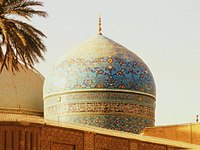Sufi studies
One of the earliest sociological treatments of Sufism is to be found in Sir John Malcolm's 1825 work, The History of Persia, From the Most Early Period to the Present Time, Containing an Account of the Religion, Government, Usages and Character of the Inhabitants of that Kingdom.
In An Account of the Manners and Customs of the Modern Egyptians written in Egypt during the years 1833-1835 (1836) Edward William Lane noted, and illustrated with his own woodcuts, his close observations of the Rifa'i derwishes while living in Cairo "in disguise".
Sir Richard Burton's Personal Narrative of a Pilgrimage to El-Medinah and Meccah (3 vol.1855-1856) was undertaken while travelling as a Qadiri, and Armin Vambéry reached Baveddin near Bokhara to visit the shrine of Baha-ud-Din Naqshband Bukhari in 1863 in the guise of a murid.
Voyage dans l'Asie Centrale, de Téhéran a Khiva, Bokhara et Samarkand, par Arminius Vambéry, savant Hongrois déguisé en derviche was the subject of four instalments of the popular and copiously illustrated "Le Tour Du Monde, Nouveau Journal Des Voyages (Édouard Charton)" Paris, Londres, Leipzig 1865, deuxième semestre -Hachette et Cie ed.
The "disguise" was by no means superficial and necessitated a variety of resources in linguistics and social integration that left marks far beyond the mere popular success of travelogues.
Towards the end of the 19th century, the resistance to the European conquest of North Africa was often led by Sufis, notably Abd al-Qadir and later the Sanusi order.
When he returned to Paris from his travels in the East in 1909, he found a mind receptive to his own spiritual affiliation in the person of René Guénon whom in turn he initiated into the Shadhili Order (1912).René Guénon – who finally settled in Cairo where he died (1951) a convert to Islam under his adopted name of Abdel Wahid Yahia – had an enormous influence on a circle of friends centered around the periodical "La Gnose", that he had started in 1909.
Frithjof Schuon, Titus Burckhardt, Marco Pallis, Ananda Coomaraswamy, Martin Lings e.a., each with his own focus on Islam, Buddhism, Hinduism ... (see also: Gershom Scholem on Judaism, Kabbalah) René Guénon focused on a measure of criticism towards what he called "solidified" (petrified) forms of initiation in the West; Freemasonry in particular which he sought to revive in reference to Emir Abd Al-Qadir whose name was widely respected among Masons.
Seminal research on the inspiration of Ibn Arabi and the Shadili and its projection in the works of Dante and St John of the Cross came from the great Christian scholar Miguel Asín Palacios The Akbari already had a history of initiation in Western Europe in the person of Emir Abd Al-Qadir, the noble opponent of the French in their colonial struggle over Algeria, who they had held sequestered at the Château d'Amboise (1848–1853).
A moving account of the circumstances of his death is given by the great African traditionalist and cultural ambassador Amadou Hampâté Bâ, himself a Tijani, in the biography of his own sheikh, Tierno Bokar.
By 1922, his introduction to the technical lexicon of Sufism and the Passion of Al-Hallaj initiated the first line of textual study, translation and publication of sources that developed into the watershed of which the chief engineers were Henry Corbin and Seyyed Hossein Nasr.
It is clear that Seyyed Hossein Nasr's participation in the collaboration with Henry Corbin infused this field with a genuine consideration for some of the finer aspects (Irfan) of Islamic culture as seen from a proper native source – Iran – and adding a distinct contemporary sting to ecology.
Both describe the control over the "nafs", the spiritual "breaths" that color man's essential character; a study comparing intelligence in its western and eastern traditional form.
Professor Reza Arasteh M. D. (remembered for his correspondence [1] with Thomas Merton) wrote in honour of Sayyid Idries Shah, whose stature as a scholar was as fiercely disputed as his communication to a general public was successful.
Nevertheless, Sayyid Idries Shah caused the English feed of the watershed to be explored – through his own accessible style of writing, by providing affordable publications of great classical texts, and rebelliously askew on the niceties of an Oxford/Cambridge kind of rivalry over Pr.
Arberry – and to exactly what extent can now easily be verified by the student willing to compare for himself the eleven Naqshbandi rules or exercise-aims listed by Sayyid Idries Shah in chapter VII of Oriental Magic in 1957 with those presently divulged through the proper channel [2].
